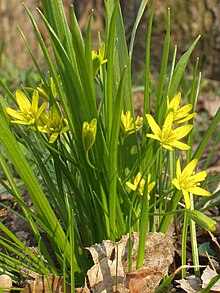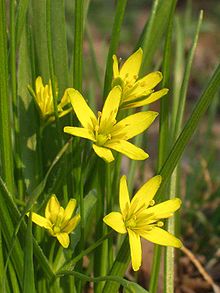Gagea
Appearance
This article needs additional citations for verification. (December 2009) |
| Gagea | |
|---|---|

| |
| Gagea lutea | |
| Scientific classification | |
| Kingdom: | |
| (unranked): | |
| (unranked): | |
| Order: | |
| Family: | |
| Subfamily: | |
| Genus: | Gagea |
| Species | |
|
over 100 | |
Gagea is a large genus of spring flowers in the Liliaceae found in Europe and western Asia. It is named after the English naturalist Sir Thomas Gage. They were originally described as species of Ornithogalum, which, together with the usual yellow colour of the flowers, explains the English name Yellow Star-of-Bethlehem for the most common species in Europe, Gagea lutea, which grows in damp deciduous woodland.
Taxonomy
The genus Lloydia has at times been considered distinct from Gagea,[1] but is now included within it.[2]
Species
As of January 2014[update], the World Checklist of Selected Plant Families recognizes over 200 species, including those previously assigned to Lloydia.[3]
- Gagea afghanica A.Terracc.
- Gagea aipetriensis Levichev
- Gagea alashanica Y.Z.Zhao & L.Q.Zhao
- Gagea alberti Regel
- Gagea alexeenkoana Miscz.
- Gagea alexejana Kamelin ex Levichev
- Gagea alexii Ali & Levichev
- Gagea algeriensis (Chabert) Chabert ex Batt.
- Gagea alii Levichev
- Gagea altaica Schischk. & Sumnev.
- Gagea ancestralis Levichev
- Gagea angelae Levichev & Schnittler
- Gagea angrenica Levichev
- Gagea anisopoda Popov
- Gagea artemczukii Krasnova
- Gagea azutavica Kotukhov
- Gagea baluchistanica Levichev & Ali
- Gagea baschkyzylsaica Levichev
- Gagea bashoensis Ali
- Gagea bergii Litv.
- Gagea bezengiensis Levichev
- Gagea bithynica Pascher
- Gagea bohemica (Zauschn.) Schult. & Schult.f. (syn. G. fistulosa) - Early Star-of-Bethlehem, Radnor Lily
- Gagea bornmuelleriana Pascher
- Gagea bowes-lyonii Levichev
- Gagea brevistolonifera Levichev
- Gagea bulbifera (Pall.) Salisb.
- Gagea caelestis Levichev
- Gagea calantha Levichev
- Gagea calcicola Zarrei & Wilkin
- Gagea calyptrifolia Levichev
- Gagea capillifolia Vved.
- Gagea capusii A.Terracc.
- Gagea caroli-kochii Grossh.
- Gagea chabertii A.Terracc.
- Gagea chanae Grossh.
- Gagea charadzeae Davlian.
- Gagea chinensis Y.Z.Zhao & L.Q.Zhao
- Gagea chitralensis S.Dasgupta & D.B.Deb
- Gagea chlorantha (M.Bieb.) Schult. & Schult.f.
- Gagea chloroneura Rech.f.
- Gagea chomutovae (Pascher) Pascher
- Gagea chrysantha (Jan) Schult. & Schult.f.
- Gagea circumplexa Vved.
- Gagea commutata K.Koch
- Gagea confusa A.Terracc.
- Gagea cuneata Levichev & Murtaz.
- Gagea czatkalica Levichev
- Gagea daghestanica Levichev & Murtaz.
- Gagea daqingshanensis L.Q.Zhao & Jie Yang
- Gagea davlianidzeae Levichev
- Gagea dayana Chodat & Beauverd
- Gagea delicatula Vved.
- Gagea deserticola Levichev
- Gagea divaricata Regel
- Gagea drummondii Levichev & Ali
- Gagea dschungarica Regel
- Gagea dubia A.Terracc.
- Gagea durieui Parl. ex Trab.
- Gagea eleonorae Levichev
- Gagea elliptica (A.Terracc.) Prain
- Gagea exilis Vved.
- Gagea extremadurensis M.Gut. & F.M.Vázquez
- Gagea fedtschenkoana Pascher
- Gagea ferganica Levichev
- Gagea fibrosa (Desf.) Schult. & Schult.f.
- Gagea filiformis (Ledeb.) Kar. & Kir.
- Gagea flavonutans (H.Hara) Zarrei & Wilkin
- Gagea foliosa (C.Presl) Schult. & Schult.f.
- Gagea gageoides (Zucc.) Vved.
- Gagea germainae Grossh.
- Gagea glacialis K.Koch
- Gagea glaucescens Levichev
- Gagea goljakovii Levichev
- Gagea gracillima Pamp.
- Gagea graeca (L.) Irmsch.
- Gagea graminifolia Vved.
- Gagea granatellii (Parl.) Parl.
- Gagea granulosa Turcz.
- Gagea grey-wilsonii Rech.f.
- Gagea gymnopoda Vved.
- Gagea gypsacea Levichev
- Gagea helenae Grossh.
- Gagea hiensis Pascher
- Gagea hissarica Lipsky
- Gagea humicola Levichev
- Gagea huochengensis Levichev
- Gagea ignota Levichev
- Gagea incrustata Vved.
- Gagea intercedens Pascher
- Gagea iranica Zarrei & Zarre
- Gagea jaeschkei Pascher
- Gagea japonica Pascher
- Gagea jensii Levichev & Schnittler
- Gagea jispensis Ali & Levichev
- Gagea joannis Grossh.
- Gagea juliae Pascher
- Gagea kamelinii Levichev
- Gagea kneissea J.Thiébaut
- Gagea kopetdagensis Vved.
- Gagea kunawurensis (Royle) Greuter
- Gagea kuraiensis Levichev
- Gagea kuraminica Levichev
- Gagea lacaitae A.Terracc.
- Gagea leosii Ali & Levichev
- Gagea libanotica (Hochst.) Greuter. syn Lloydia rubroviridis
- Gagea liotardii (Sternb.) Schult. & Schult.f.
- Gagea lojaconoi Peruzzi
- Gagea longiscapa Grossh.
- Gagea ludmilae Levichev
- Gagea lusitanica A.Terracc.
- Gagea lutea (L.) Ker Gawl. - Yellow Star-of-Bethlehem
- Gagea luteoides Stapf
- Gagea maeotica Artemczuk
- Gagea marchica Henker
- Gagea menitskyi Levichev
- Gagea mergalahensis Ali & Levichev
- Gagea michaelis Golosk.
- Gagea micrantha (Boiss.) Pascher
- Gagea minima (L.) Ker Gawl.
- Gagea minutiflora Regel
- Gagea minutissima Vved.
- Gagea multipedunculifera Levichev
- Gagea nabievii Levichev
- Gagea nakaiana Kitag.
- Gagea neopopovii Golosk.
- Gagea nevadensis Boiss.
- Gagea noltiei Peruzzi. syn Lloydia delicatula
- Gagea novoascanica Klokov
- Gagea olgae Regel
- Gagea paedophila Vved.
- Gagea pakistanica Levichev & Ali
- Gagea paniculata Levichev
- Gagea pauciflora (Turcz. ex Trautv.) Ledeb.
- Gagea pedata Levichev
- Gagea peduncularis (C.Presl) Pascher
- Gagea podolica Schult. & Schult.f.
- Gagea polymorpha Boiss.
- Gagea popovii Vved.
- Gagea praemixta Vved.
- Gagea pratensis (Pers.) Dumort. - Meadow Gagea
- Gagea pseudominutiflora Levichev
- Gagea punjabica Levichev & Ali
- Gagea pusilla (F.W.Schmidt) Sweet
- Gagea quasitenuifolia Levichev
- Gagea quettica Levichev & Ali
- Gagea rawalpindica Levichev & Ali
- Gagea reinhardii Levichev
- Gagea reticulata (Pall.) Schult. & Schult.f.
- Gagea reverchonii Degen
- Gagea rigida Boiss. & Spruner
- Gagea robusta Zarrei & Wilkin
- Gagea rubicunda Meinsh.
- Gagea rubinae Ali
- Gagea rufidula Levichev
- Gagea rupicola Levichev
- Gagea sarmentosa K.Koch
- Gagea sarysuensis Murz.
- Gagea schachimardanica Levichev
- Gagea schugnanica Levichev & Navruzsh.
- Gagea scythica Artemczuk
- Gagea serotina (L.) Ker Gawl. (syn. Lloydia serotina)
- Gagea setifolia Baker
- Gagea shmakoviana Levichev
- Gagea sicula Lojac.
- Gagea siphonantha Rech.f.
- Gagea sivasica Hamzaoglu
- Gagea soleirolii F.W.Schultz
- Gagea spathacea (Hayne) Salisb.
- Gagea spumosa Levichev
- Gagea staintonii Rech.f.
- Gagea stepposa L.Z.Shue
- Gagea subtilis Vved.
- Gagea subtrigona J.-M.Tison
- Gagea sulfurea Miscz.
- Gagea tadshikistanica Levichev
- Gagea takhtajanii Levichev
- Gagea talassica Levichev
- Gagea taschkentica Levichev
- Gagea taurica Steven
- Gagea tenera Pascher
- Gagea tenuissima Miscz.
- Gagea tesquicola Krasnova
- Gagea tisoniana Peruzzi
- Gagea toktogulii Levichev
- Gagea toppinii S.Dasgupta & D.B.Deb
- Gagea transversalis (Pall.) Steven
- Gagea triflora (Ledeb.) Schult. & Schult.f.
- Gagea trinervia (Viv.) Greuter
- Gagea turanica Levichev
- Gagea ucrainica Klokov
- Gagea ugamica Pavlov
- Gagea ulazsaica Levichev
- Gagea uliginosa Siehe & Pascher
- Gagea utriculosa Levichev
- Gagea vaginata Pascher
- Gagea vegeta Vved.
- Gagea villosa (M.Bieb.) Sweet - Field Gagea
- Gagea villosula Vved.
- Gagea vvedenskyi Grossh.
- Gagea wallichii Levichev & Ali
- Gagea wendelboi Rech.f.
- Gagea xiphoidea Levichev
Currently there remain some unplaced names under Lloydia:[4]
- Lloydia delavayi Franch.
- Lloydia ixiolirioides Baker ex Oliv.
- Lloydia longiscapa Hook.
- Lloydia oxycarpa Franch.
- Lloydia tibetica Baker ex Oliv.
- Lloydia yunnanensis Franch.

References
- ^ Tutin, T.G.; Heywood, V.H.; Burges, N.A.; Moore, D.M.; Valentine, D.H.; Walters, S.M.; Webb, D.A., eds. (1980). Flora Europaea. Vol. 5. Cambridge University Press. ISBN 978-0-521-20108-7.
{{cite book}}: Unknown parameter|lastauthoramp=ignored (|name-list-style=suggested) (help) p. 25. - ^ "Lloydia". World Checklist of Selected Plant Families. Royal Botanic Gardens, Kew. Retrieved 2014-01-09.
- ^ "Gagea". World Checklist of Selected Plant Families. Royal Botanic Gardens, Kew. Retrieved 2014-01-09.
- ^ "Build a checklist for Lloydia (Liliaceae)". World Checklist of Selected Plant Families. Royal Botanic Gardens, Kew. Retrieved 2014-01-10.
Wikimedia Commons has media related to Gagea.
